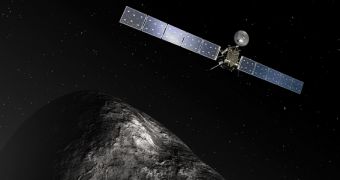The Rosetta spacecraft, currently on its way to meet up with comet 67P/Churyumov–Gerasimenko this May, managed to reactivate another batch of science instruments over the past week, officials from the European Space Agency (ESA) announced on Tuesday, March 25. This is the second week dedicated to the recommissioning process, which is thus far progressing smoothly and on schedule.
ESA science and operations team are currently handling the procedures and tests associated with waking up the instruments aboard Rosetta, which have been slumbering for more than two years. At the same time, engineers are assessing the overall health levels of the spacecraft. These are parameters that need to be known before the prove can enter obit around its cometary target.
One of the most important tasks currently being performed on the spacecraft is testing the reaction wheels that maintain its orientation and position in space. At this point, the wheels spin at a slow rate of 250 rotations per minute (RPM), and will continue to do so until engineers gather enough data to accurately predict their actions at higher RPM.
Thus far, the radio science investigation (RSI) and the Standard Radiation Monitor (SRM) instruments have been turned on, and communications with Earth established – via the ESA New Norcia listening station and the NASA Deep Space Network. Radio signals currently take 36 minutes and 56 seconds to reach Rosetta. The probe is 664 million (413 million miles) kilometers away from Earth.

 14 DAY TRIAL //
14 DAY TRIAL //